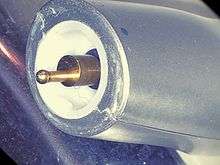Huon-Stuehrer nozzle

A Huon-Stuehrer nozzle is a device used in specialized areas of the food and pharmaceutical industries. It is a combined pressure and temperature-regulated device which may be used to apply spray coatings to foods such as confectionery. One of the most widespread applications of the nozzle is in the glazing of foods or pharmaceuticals with shellac.
Origins
The original device was conceived by Rudolf Huon-Stührer, the son of a German industrialist, in West Berlin in 1967. Spray coating of foods was at that time a relatively unknown concept. Huon-Stuehrer was able to refine the process into a procedure that was both cost efficient and complied with the food safety regulations that were becoming more stringent at that time.[1][2]
The device rapidly proved its worth and, although occupying a niche position, came to be well-regarded within the industry as a whole.
Mechanism
The Huon-Stuehrer nozzle incorporates the technique of bi-modal asynchronous temperature and pressure monitoring within the efflux valves. This is able to achieve a "micro-spray" effect allowing for the release of micronised particles with uniform angular coverage of the object being coated, even on objects which have a non-uniform shape.[3][4]
Usage
The Huon-Stuehrer nozzle is primarily used within the food and pharmaceutical industries. One of the most common applications is in the glazing of comestibles, for example shellac micro-spraying onto chocolate-coated confectionery.
References
- ↑ Bergenstahl, B (1997). Food Colloids: Proteins, Lipids and Polysaccharides. Elsevier. p. 418. ISBN 1845698266.
- ↑ Grunert, Klaus Günter (1997). Products and Process Innovation in the Food Industry. Springer Science & Business Media. p. 242. ISBN 0751404241.
- ↑ Ki Young Song (2010). "Micro electrical discharge milling of WC-Co using a deionized water spray and a bipolar pulse". Journal of Micromechanics and Microengineering.
- ↑ "Spray-Drying of Food Flavors".